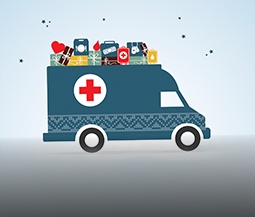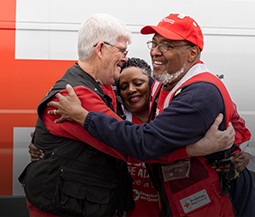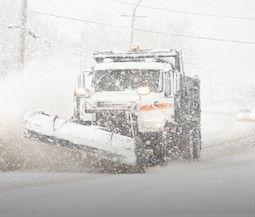The American Red Cross is responding across multiple states after deadly storms caused damage across the South and Midwest over the weekend.
The threat of severe weather continues today, affecting almost 90 million people along the I-95 corridor from North Carolina to New York City. Strong thunderstorms, hail and tornadoes are possible and heavy rain could cause flash flooding. The Red Cross is monitoring the situation and preparing to respond if necessary. People in the path of this severe storm system are urged to monitor their weather and take safety steps if necessary.
Extreme heat also continues today for millions of people from Arizona to Tennessee. Heat warnings and advisories are out and people are urged to follow heat safety measures.
BUSY WEEKEND Over the weekend, severe storms and tornadoes were reported in Arkansas, Indiana, Minnesota, Missouri, Kentucky, Tennessee, Virginia and Wyoming. Red Cross teams are actively responding to these Regions and helping to provide comfort and care to those impacted. The Red Cross and partners are working with officials to determine what additional help is needed and shelters are open in Texas, Mississippi, Illinois, Indiana and North Carolina.
Meanwhile, help continues for people impacted by storms earlier this month. Red Cross disaster workers remain on the ground in Louisiana, Oklahoma, Texas and Mississippi after severe weather and tornadoes caused widespread damage.
CLIMATE CRISIS Experts say these storms are unusual for this time of year, that conditions like these usually happen in August. Some say climate change is impacting the conditions in which tornadoes form and could lead to changes in when and where the U.S. sees them.
Disasters are becoming more extreme. Over the last 30 years, the intensity of storms has progressively increased. As climate-related disasters increase, more people are depending on the Red Cross for help. During 2020 and 2021 alone, we averaged a new, major disaster response every 10 days. This new reality of nearly continuous disasters is stretching the capacity of the Red Cross to provide critical support to families when they need it most.
SAFETY STEPS If you are in the path of these storms, follow these safety steps:
TORNADOES
- Watch for tornado danger signs: dark and greenish clouds, a wall cloud or cloud of debris.
- During a tornado warning, go to your safe place immediately, whether it’s a basement, storm cellar or interior room on the lowest floor with no windows. A small, windowless interior room or hallway on the lowest level of a sturdy building is the safest alternative.
- If you live in a mobile home, find a safe place in a nearby sturdy building. No mobile home is safe in a tornado. If you have access to a sturdy shelter or vehicle, go there immediately.
- If you’re outside, seek shelter in a basement, shelter or sturdy building. If you cannot quickly walk to a shelter, immediately get in a vehicle and try to drive to the closest sturdy shelter. Remember to buckle your seat belt.
- Stay away from bridges or highway overpasses.
- If strong winds and flying debris occur while driving, pull over and park. Keep on your seat belt and the engine running. Put your head down below the windows and cover your head with your hands and a blanket.
THUNDERSTORMS
When Thunder Roars, Go Indoors!
- Pay attention to weather alerts and local information. Postpone outdoor activities if the forecast calls for thunderstorms.
- When you hear thunder, seek shelter inside a sturdy building and move to a basement or an interior room on the lowest floor. Stay away from glass windows and doors. Stay inside until weather forecasts indicate it is safe to leave.
- Lightning can be dangerous even when you are inside. Avoid using devices connected to electrical outlets. Avoid running water. Lightning can travel through plumbing and water lines.
- Remember, no place outside is safe when thunderstorms are in the area. If you are caught outside in a thunderstorm, keep moving toward a safe shelter.
- Sheds, gazebos, dugouts, and bleachers do not protect from lightning and high winds.
- It is dangerous to take shelter under a tree as it is the leading cause of death from lightning strikes. You could also be killed or injured by strong winds blowing down trees and branches.
- Being in a vehicle is safer than being outside; however, if you have time, drive to the closest sturdy building, and take shelter inside.
- If you are driving and can’t get to a sturdy building, pull off the road and park in a place where falling trees and power lines won’t hit you.
- Flash flooding happens quickly. Move to higher ground before floodwaters reach you. Never walk, swim, or drive through floodwater.
POWER OUTAGE
- Use flashlights in the dark — not candles.
- Eliminate unnecessary travel, especially by car. Traffic lights will be out and roads will likely be congested.
- Turn off and unplug all unnecessary electrical equipment and appliances. When power comes back on, surges or spikes can damage equipment.
- Leave one light on, so you’ll know when power is restored.
- Never use a generator, grill, camp stove or other gasoline, propane, natural gas or charcoal-burning devices inside a home, garage, basement, crawlspace or any partially enclosed area. Keep these devices outside away from doors, windows and vents, which could allow carbon monoxide to come indoors.
- During a prolonged outage, keep refrigerator and freezer doors closed as much as possible to protect your food. Use perishable food from the refrigerator first, then, food from the freezer. If the power outage continues beyond a day, prepare a cooler with ice for your freezer items. Keep food in a dry, cool spot and cover it at all times.
EXCESSIVE HEAT
- Hot cars can be deadly. Never leave children or pets in your vehicle. The inside temperature of the car can quickly reach 120 degrees.
- Stay hydrated by drinking plenty of fluids. Avoid drinks with caffeine or alcohol.
- Check on family, friends and neighbors who do not have air conditioning, who spend much of their time alone or who are more likely to be affected by the heat.
- Adults age 65 and older, those with chronic medical conditions, people who work outside, infants and children and athletes may feel the effects of the heat more than others.
- If you don’t have air conditioning, seek relief from the heat during the warmest part of the day in places like schools, libraries, theaters, malls, etc.
- Avoid extreme temperature changes.
- Wear loose-fitting, lightweight, light-colored clothing. Avoid dark colors because they absorb the sun’s rays.
- Slow down, stay indoors and avoid strenuous exercise during the hottest part of the day.
- Postpone outdoor games and activities.
- Use a buddy system when working in excessive heat. Take frequent breaks if working outdoors.
Download the free Red Cross First Aid app so you’ll know what to do if emergency help is delayed and the free Emergency app for weather alerts, open Red Cross shelter locations and safety steps for different emergencies. Choose whether you want to view the content in English or Spanish with an easy-to-find language selector. Find these and all of the Red Cross apps in smartphone app stores by searching for the American Red Cross or going to redcross.org/apps.












